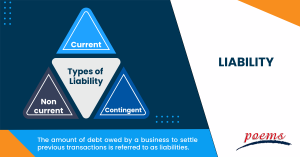Liability
Table of Contents
Liability
As a small business owner, you might owe money to suppliers, staff members, and the government. In your accounting records, you must maintain records of the debts owed by your company. Mark your debts as liabilities to keep track of the money you owe.
Liabilities are past-due debts owed by your company to another company, group, vendor, worker, or government body. Debts are acquired via routine company operations.
What is a liability?
The amount of debt owed by a business to settle previous transactions is referred to as liabilities. This money may belong to the corporation rather than its lenders, banks, or other lenders or financial organisations. The balance statement lists these as credits in the order of payment terms.
Any business organisation’s liability is a crucial component and is frequently a reliable indicator of how well-off and financially stable a corporation is. It is essential because liabilities suggest that a business must eventually give another organisation financial benefits. Examples of liabilities include debtors, bank loans, and so forth.
Understanding liability
A liability is an obligation one party owes to another that hasn’t been met or paid for. In the field of accounting, a commitment is a financial liability. However, it is more particularly defined by past commercial dealings, occasions, sales, trades of commodities or services, or anything else that will provide income in the future. Current liabilities are considered short-term obligations, whereas non-current liabilities are long-term.
Liabilities are future financial sacrifices that a business must make for other entities as a result of previous occurrences or previous transactions. A company’s liabilities must be managed effectively to prevent a solvency crisis or, in the worst situation, bankruptcy. Liabilities can be classified as current, non-current, or contingent.
Types of liability

Liabilities are primarily categorised based on when they are due. The company’s ability to manage its financial obligations depends on the classification. They are as follows:
- Current liabilities
Current obligations are those with a one-year maturity date. These typically happen throughout regular business activities. Due to the short-term nature of these financial commitments, management should consider the company’s liquidity.
- Non-current liabilities
Obligations that are due after more than a year are referred to as non-current or long-term liabilities. It is crucial that short-term duties, such as short-term loans or the current element of long-term debt, are not included in the non-current liabilities.
- Contingent liabilities
Contingent liabilities are potential liabilities that come to pass in a fictitious incident. These might take place. As a result, only commitments with a larger than 50% likelihood of occurring are recorded in accounting records. Still unresolved liabilities include lawsuits, government inquiries, liquidated damages, and product warranties.
How liabilities work
When you purchase your company, you have two options for paying: cash from your checking account or a loan. Either way, borrowing creates a debt that must be repaid at some point, either in cash or by using other assets.
For instance, using a credit card to make purchases from suppliers is a type of borrowing that, unless paid off at the end of the month, creates a liability for your company. Similar penalties result from obtaining a bank overdraft, a business loan, or a mortgage on real estate used for business purposes. Corporate operations like paying staff and collecting sales tax from clients can also result in liabilities.
Your company’s balance sheet, a financial statement that depicts the state of the business after an accounting period, lists liabilities. The business’s assets, or what it owns, are displayed on the left, while its obligations and owners’ equity are displayed on the right. Typically, the liabilities are shown above the owners’ equity because they will be paid back if a company files for bankruptcy.
Example of liabilities
Examples of liabilities are:
- Defaulted loans
- Plans for paying for purchased equipment
- Supplier payments that are due
- Expenses required for goods or services obtained
- Accrued income (worker compensation not yet paid)
- Interest due on outstanding bonds or preferred shares.
- Unpaid fines or responsibilities to the law
- Unpaid pension contributions
- Client deposits
- Taxes owing
Frequently Asked Questions
Liabilities are a company’s financial obligations, while assets are a company’s resources. Equity is the owner’s investment in the company.
Liabilities and assets are always equal because an equal amount of assets offsets every company’s liability. For example, if a company owes US$1,000 in liabilities, it will have US$1,000 in assets to offset that debt. Equity is the difference between the two, representing the owner’s investment in the company.
In simple terms, liabilities are what a company owes, assets are what a company owns, and equity is the owner’s investment.
A contingent obligation is a duty or potential loss that might exist in the future depending on how a specific event turns out. Investigations that are still open, product warranties, and prospective lawsuits can all lead to contingent liability.
A company’s non-current obligations are those that it anticipates taking longer than current liabilities to pay off. Liabilities are divided into existing and non-current categories on the balance sheet. Non-current commitments are sometimes known as long-term liabilities.
Liabilities are reported on a company’s balance sheet. According to the accounting equation, the total number of penalties must match the difference between the total amount of assets and the total amount of equity. According to accepted accounting rules, liabilities must be declared.
While both assets and liabilities are important financial concepts, there is one key difference between the two: assets represent something of value that a company owns, while liabilities represent something that a company owes. This key difference is important to understand when evaluating a company’s financial position.
Assets are important because they can generate revenue or create value for the company. For example, a company might own a factory that it uses to produce goods. The factory is an asset because it can generate revenue for the company. Liabilities, on the other hand, are important because they represent a financial obligation that a company must pay. For example, a company might have a loan from a bank. The loan is a liability because the company must make payments to the bank.
Related Terms
- Trailing Stops
- Exchange Control
- Relevant Cost
- Dow Theory
- Hyperdeflation
- Hope Credit
- Futures contracts
- Human capital
- Subrogation
- Qualifying Annuity
- Strategic Alliance
- Probate Court
- Procurement
- Holding company
- Harmonic mean
- Trailing Stops
- Exchange Control
- Relevant Cost
- Dow Theory
- Hyperdeflation
- Hope Credit
- Futures contracts
- Human capital
- Subrogation
- Qualifying Annuity
- Strategic Alliance
- Probate Court
- Procurement
- Holding company
- Harmonic mean
- Income protection insurance
- Recession
- Savings Ratios
- Pump and dump
- Total Debt Servicing Ratio
- Debt to Asset Ratio
- Liquid Assets to Net Worth Ratio
- Liquidity Ratio
- Personal financial ratios
- T-bills
- Payroll deduction plan
- Operating expenses
- Demand elasticity
- Deferred compensation
- Conflict theory
- Acid-test ratio
- Withholding Tax
- Benchmark index
- Double Taxation Relief
- Debtor Risk
- Securitization
- Yield on Distribution
- Currency Swap
- Overcollateralization
- Efficient Frontier
- Listing Rules
- Green Shoe Options
- Accrued Interest
- Market Order
- Accrued Expenses
- Target Leverage Ratio
- Acceptance Credit
- Balloon Interest
- Abridged Prospectus
- Data Tagging
- Perpetuity
- Hybrid annuity
- Investor fallout
- Intermediated market
- Information-less trades
- Back Months
- Adjusted Futures Price
- Expected maturity date
- Excess spread
- Quantitative tightening
- Accreted Value
- Equity Clawback
- Soft Dollar Broker
- Stagnation
- Replenishment
- Decoupling
- Holding period
- Regression analysis
- Wealth manager
- Financial plan
- Adequacy of coverage
- Actual market
- Credit risk
- Insurance
- Financial independence
- Annual report
- Financial management
- Ageing schedule
- Global indices
- Folio number
- Accrual basis
- Liquidity risk
- Quick Ratio
- Unearned Income
- Sustainability
- Value at Risk
- Vertical Financial Analysis
- Residual maturity
- Operating Margin
- Trust deed
- Leverage
- Profit and Loss Statement
- Junior Market
- Affinity fraud
- Base currency
- Working capital
- Individual Savings Account
- Redemption yield
- Net profit margin
- Fringe benefits
- Fiscal policy
- Escrow
- Externality
- Multi-level marketing
- Joint tenancy
- Liquidity coverage ratio
- Hurdle rate
- Kiddie tax
- Giffen Goods
- Keynesian economics
- EBITA
- Risk Tolerance
- Disbursement
- Bayes’ Theorem
- Amalgamation
- Adverse selection
- Contribution Margin
- Accounting Equation
- Value chain
- Gross Income
- Net present value
- Leverage ratio
- Inventory turnover
- Gross margin
- Collateral
- Being Bearish
- Being Bullish
- Commodity
- Exchange rate
- Basis point
- Inception date
- Riskometer
- Trigger Option
- Zeta model
- Racketeering
- Market Indexes
- Short Selling
- Quartile rank
- Defeasance
- Cut-off-time
- Business-to-Consumer
- Bankruptcy
- Acquisition
- Turnover Ratio
- Indexation
- Fiduciary responsibility
- Benchmark
- Pegging
- Illiquidity
- Backwardation
- Backup Withholding
- Buyout
- Beneficial owner
- Contingent deferred sales charge
- Exchange privilege
- Asset allocation
- Maturity distribution
- Letter of Intent
- Emerging Markets
- Consensus Estimate
- Cash Settlement
- Cash Flow
- Capital Lease Obligations
- Book-to-Bill-Ratio
- Capital Gains or Losses
- Balance Sheet
- Capital Lease
Most Popular Terms
Other Terms
- Physical ETF
- Initial Public Offering
- Buyback
- Secondary Sharing
- Bookrunner
- Notional amount
- Negative convexity
- Jumbo pools
- Inverse floater
- Forward Swap
- Underwriting risk
- Reinvestment risk
- Final Maturity Date
- Payment Date
- Secondary Market
- Margin Requirement
- Mark-to-market
- Pledged Asset
- Yield Pickup
- Subordinated Debt
- Treasury Stock Method
- Stochastic Oscillator
- Bullet Bonds
- Basket Trade
- Contrarian Strategy
- Notional Value
- Speculation
- Stub
- Trading Volume
- Going Long
- Pink sheet stocks
- Rand cost averaging
- Sustainable investment
- Stop-limit sell order
- Economic Bubble
- Ask Price
- Constant prepayment rate
- Covenants
- Stock symbol
- Companion tranche
- Synthetic replication
- Bourse
- Beneficiary
- Witching Hour
- Widow and Orphan stock
- Public Float
- Closing Price
- Reverse stock splits
- Quiet period
- Prepayment risk
Know More about
Tools/Educational Resources
Markets Offered by POEMS
Read the Latest Market Journal

Back in Business: The Return of IPOs & Top Traded Counters in March 2024
Start trading on POEMS! Open a free account here! At a glance: Major indices continue...

Weekly Updates 15/4/24 – 19/4/24
This weekly update is designed to help you stay informed and relate economic and company...

From $50 to $100: Unveiling the Impact of Inflation
In recent years, inflation has become a hot topic, evoking strong emotions as the cost...

Japan’s Economic Resurgence: Unveiling the Tailwinds Behind Nikkei 225’s Record Leap
Source: eSignal, Intercontinental Exchange, Inc. In the heart of Japan’s economic landscape, the Nikkei 225...

Weekly Updates 8/4/24 – 12/4/24
This weekly update is designed to help you stay informed and relate economic and...

What Makes Forex Trading Attractive?
In a world where the click of a button can send goods across oceans and...

Weekly Updates 1/4/24 – 5/4/24
This weekly update is designed to help you stay informed and relate economic and company...

How to soar higher with Positive Carry!
As US Fed interest rates are predicted to rise 6 times this year, it’s best...












